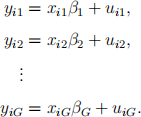ECON0060 Problem Set 1
Hello, dear friend, you can consult us at any time if you have any questions, add WeChat: daixieit
ECON0060
Problem Set 1
Question 1
Consider a system of seemingly unrelated regressions

Here, yig and uig are scalars and xig is a Kg vector for g = 1, . . . , G. As in the lecture we introduce the G-vectors yi = (yi1, . . . , yiG)' and ui = (ui1, . . . , uiG)' , and the ( Kg)-vector β and G × (
Kg)-vector β and G × ( Kg) matrix Xi as follows
Kg) matrix Xi as follows

Let  . The OLS and GLS estimator read
. The OLS and GLS estimator read

Show that  if one of the following two conditions is satisfied:
if one of the following two conditions is satisfied:
(a) if Σ is a diagonal matrix, i.e. Σ = diag( , . . . ,
, . . . ,  ), with
), with  = E(
= E( |Xi) > 0.
|Xi) > 0.
(b) if the regressors in all G equations are identical, i.e. xig = xi for all g = 1, . . . , G.
Question 2
Consider the two seemingly unrelated regression equations

Here, the first equation only contains a constant regressor, while the second contains a constant and an additional regressor xi . Assume that

across i = 1, . . . , n. Let −1 < ρu < 1 and −1 < ρx < 1. Also define

The OLS and GLS estimator for β are given by

(a) Assume ρx = 0. Are  and
and  consistent estimators for β? Explain.
consistent estimators for β? Explain.
(b) Assume ρx = 0. Calculate and compare the asymptotic variances of  and
and  .
.
(you can use the results from the lecture notes).
(c) Assume ρx ≠ 0. Are  and
and  consistent estimators for β? Explain. Are the components
consistent estimators for β? Explain. Are the components  and
and  consistent for β1 and β21?
consistent for β1 and β21?
Question 3
Consider the system of two simultaneous equations

where yi1 and yi2 are endogenous variables and xi is a single exogenous regressors. There are four scalar structural parameters α1, α2, β1 and β2. In matrix notation the structural equations can be re-written as

where yi = (yi1, yi2)', ui = (ui1, ui2)', Γ is a 2 × 2 matrix and ∆ is a 1 × 2 vector. The reduced form model can be written as

where Π = ∆Γ−1 = (π1, π2) is the 1×2 vector of reduced form parameters and  .
.
(a) Express Γ and ∆ in terms of α1, α2, β1 and β2.
(b) Calculate det(Γ). Under what condition on α1 and α2 is Γ invertible? (Hint: Γ is invertible if det(Γ) ≠ 0). In the following we assume that Γ is invertible.
(c) Express Π in terms of α1, α2, β1 and β2.
(d) Assume that β1 = 0 and π2 ≠ 0. Show that α1 is identified and find an expression for α1 in terms of π1 and π2.
(e) Assume that α1 = −α2, β1 = β2, and π1 + π2 ≠ 0. Show that all structural parameters are identified and find an expression for α1, α2, β1 and β2 in terms of π1 and π2.
Question 4
Consider the following panel data model with two time periods and one regressor

where i = 1, . . . , n indexes individuals, and t = 1, 2 indexes time periods. We assume that xi1, xi2, αi
, εi1 and εi2 are all mutually independent, are all independently distributed across i, and that  . and εit ∼ N (0, σε
2
). We assume that
. and εit ∼ N (0, σε
2
). We assume that  .
.
For each i we define the two-vectors yi = (yi1, yi2)', xi = (xi1, xi2)' and ui = (ui1, ui2)', and the 2×2 matrix  . Consider the following two estimators for the scalar parameter β
. Consider the following two estimators for the scalar parameter β

(a) Show that  is consistent as n → ∞.
is consistent as n → ∞.
(b) Find an expression for Σ in terms of  , and
, and  . Calculate the inverse of Σ.
. Calculate the inverse of Σ.
(c) Find expressions for the asymptotic variance of the two estimators in terms of only  ,
,  and
and  (you can use the general result from the lecture). Which estimator has the smaller asymptotic variance?
(you can use the general result from the lecture). Which estimator has the smaller asymptotic variance?
2024-03-21